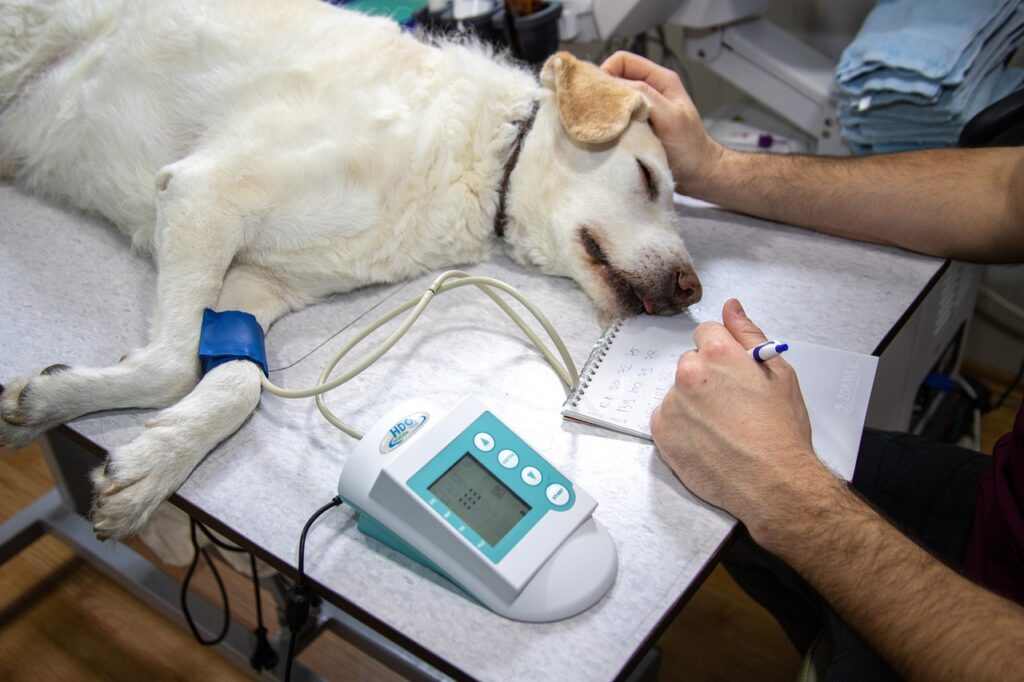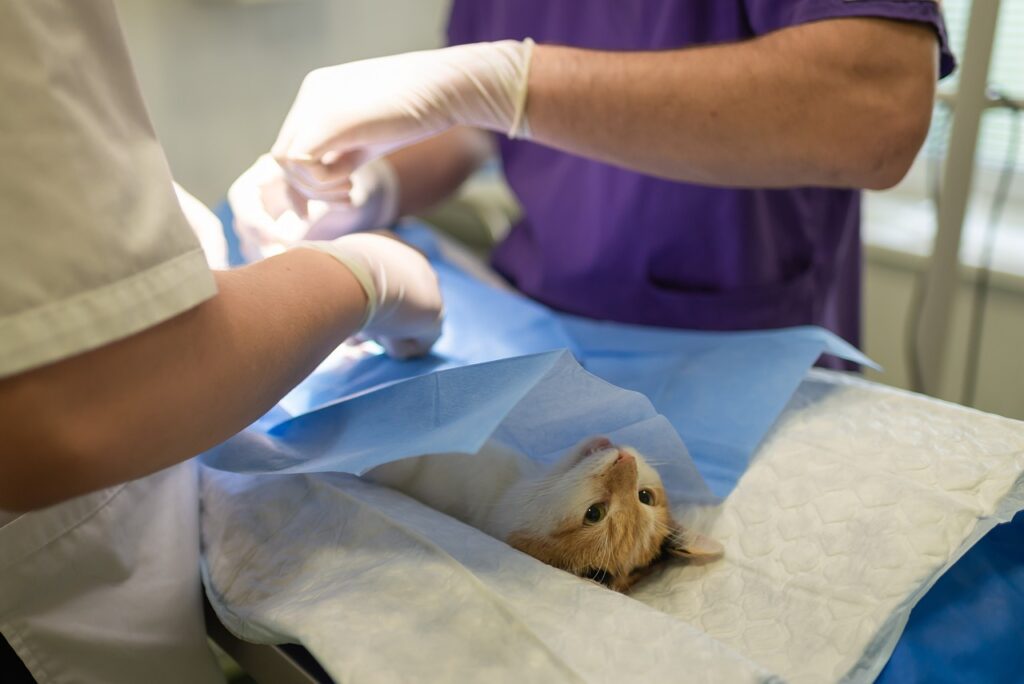The veterinary industry is witnessing a surge in the demand for skilled and qualified veterinary technicians. These professionals play a crucial role in animal healthcare, supporting veterinarians in providing top-notch medical care to animals.
Veterinary technicians are responsible for a wide range of tasks, such as assisting with examinations and surgeries, administering medications, and collecting and analyzing lab samples. Their expertise is vital in ensuring the well-being of pets and other animals.
The Importance of Vet Techs in Animal Healthcare
As the first line of defense in diagnosing and treating animals, vet techs are essential to maintaining high standards of care in the veterinary field. Their skills and knowledge contribute to the overall effectiveness of animal healthcare services.
Veterinary Technician Programs

Vet Tech Programs from Penn Foster
Veterinarian Technician – Associate’s Degree

Vet Tech Programs from Purdue University
Online Veterinary Nursing Program

Vet Tech Programs from Ashworth College
Veterinary Technician – Associate’s Degree
Educational Requirements for Becoming a Veterinary Technician
Aspiring veterinary technicians must fulfill specific educational requirements to ensure they possess the necessary knowledge and skills to excel in the field. The process begins with a solid foundation and progresses through specialized training programs.
A high school diploma or GED is the first step towards becoming a veterinary technician. It is essential for individuals to have a strong background in science, particularly biology and chemistry, which serve as prerequisites for entering veterinary technology programs.
After completing high school or obtaining a GED, aspiring vet techs should enroll in an American Veterinary Medical Association (AVMA)-accredited postsecondary program. These programs typically offer an associate degree in veterinary technology, which takes approximately two years to complete. Some institutions also provide the option of pursuing a bachelor’s degree in veterinary technology, which requires four years of study.
While completing the veterinary technology program, students will cover various subjects related to animal healthcare, such as animal anatomy, physiology, pharmacology, and radiology. They will also gain hands-on experience through clinical hours and externships, ensuring they are well-prepared for their future roles as veterinary technicians.

Veterinarian Technology Programs
Veterinary technology programs, also known as veterinary technician programs, are educational pathways that prepare individuals for careers as veterinary technicians or technologists. These programs are typically offered at colleges, universities, and vocational schools and provide the necessary knowledge and skills to work in the field of veterinary medicine. Here are some key aspects of veterinary technology programs:
- Program Types:
- Associate’s Degree Programs: These are the most common and widely recognized veterinary technology programs. They typically take two years to complete and offer a comprehensive education in veterinary technology.
- Bachelor’s Degree Programs: Some institutions offer four-year bachelor’s degree programs in veterinary technology or veterinary nursing. These programs often provide a more in-depth education and may lead to more advanced career opportunities.
- Curriculum: Veterinary technology programs cover a wide range of subjects, including animal anatomy, physiology, pharmacology, radiology, surgical nursing, laboratory procedures, and animal care and management. Students also learn about ethics and communication in veterinary medicine.
- Clinical Experience: Practical experience is a crucial component of veterinary technology programs. Students typically complete clinical rotations in veterinary clinics or hospitals, gaining hands-on experience working with animals and assisting with various procedures under the supervision of licensed veterinarians or veterinary technicians.
- Accreditation: It is important to choose a program accredited by the American Veterinary Medical Association (AVMA). Accredited programs meet specific standards of quality and are more likely to prepare students effectively for their careers.
- Specializations: Some programs offer specialization tracks or elective courses in areas like anesthesia, dentistry, emergency and critical care, zoological medicine, or equine medicine, allowing students to focus on specific fields within veterinary technology.
- Online and Hybrid Programs: Some institutions offer online or hybrid (combination of online and on-campus) veterinary technology programs, which can provide flexibility for students who need to balance their education with other commitments.
When considering a veterinary technology program, it’s essential to research program accreditation, admission requirements, and the program’s success rate in preparing students for licensure or certification exams. Additionally, students should choose a program that aligns with their career goals and interests within the field of veterinary technology.
Hands-on Experience and Training
Alongside theoretical knowledge, practical experience is vital in preparing future veterinary technicians for their roles in animal healthcare. Gaining hands-on experience helps aspiring vet techs develop the necessary clinical skills to excel in their careers.
Externships and clinical hours are essential components of AVMA-accredited veterinary technology programs. These opportunities allow students to work directly with animals under the supervision of experienced veterinary professionals. Through these experiences, students can apply their classroom learning to real-world situations and develop a deeper understanding of the daily responsibilities and challenges faced by veterinary technicians.
On-the-job training plays a significant role in the development of a veterinary technician’s skills. Working in veterinary clinics, animal hospitals, and other healthcare settings, vet techs hone their abilities in various areas, including examinations, surgeries, medication administration, and laboratory procedures. This practical experience ensures they are well-prepared to handle the diverse tasks required in their profession.
Licensing and Certification
Obtaining proper licensure and certification is a crucial aspect of becoming a successful veterinary technician. These credentials ensure that vet techs meet the highest standards of professionalism and competence in their field.
One of the primary requirements for veterinary technicians is passing the Veterinary Technician National Examination (VTNE). This exam, administered by the American Association of Veterinary State Boards (AAVSB), assesses the knowledge and skills of vet techs in various areas, including animal nursing, anesthesia, surgical assistance, and diagnostic imaging. Passing the VTNE is an essential step in obtaining certification as a veterinary technician.
It is important to note that licensing and certification requirements can vary by state. Aspiring vet techs should research the specific requirements in the state where they intend to practice. These requirements may include additional examinations or the completion of continuing education courses.
Maintaining certification as a veterinary technician involves staying updated on the latest advancements in animal healthcare and participating in continuing education programs. This commitment to lifelong learning ensures that certified vet techs provide the best possible care to their animal patients.

Specializations and Career Advancement Opportunities
As a veterinary technician, there are numerous opportunities for specialization and career advancement. These vet tech specializations enable you to focus on specific areas of interest and develop expertise in niche segments of animal healthcare.
Emergency care is one such specialization, where veterinary technicians work in critical care settings to provide urgent medical attention to animals in need. This challenging and rewarding field requires a high level of skill and adaptability to handle emergency situations.
Veterinary technicians can also specialize in dentistry, focusing on the oral health of animals. In this role, vet techs assist with dental procedures, perform cleanings, and educate pet owners on maintaining their pets’ dental hygiene.
Zoological medicine is another area of specialization, where veterinary technicians work with exotic and wild animals in zoos, wildlife rehabilitation centers, and conservation organizations. This unique field allows vet techs to contribute to wildlife conservation efforts and work with a diverse range of species.
For those interested in further professional growth, becoming a veterinary tech specialist (VTS) is an option. VTS professionals possess advanced skills in specific areas of veterinary medicine, such as anesthesia, oncology, or internal medicine. This designation requires additional training and certifications, demonstrating a commitment to excellence in the field.
Finally, some veterinary technicians may choose to pursue further education to become veterinarians. This path requires several years of additional schooling, but it opens up new opportunities for career advancement and increased responsibilities in animal healthcare.
Soft Skills for Veterinary Technicians
Apart from technical knowledge and hands-on experience, several soft skills are crucial for veterinary technicians to excel in their profession. These skills help vet techs provide compassionate care to animals and effectively communicate with pet owners and colleagues.
A love for animals is the foundation of a successful veterinary technician career. This passion drives vet techs to provide the highest level of care for their patients and ensures they remain dedicated to their profession, even in challenging situations.
Strong communication skills are essential for veterinary technicians, as they frequently interact with pet owners and relay vital information to veterinarians. These skills help vet techs educate clients on proper pet care, discuss treatment options, and provide updates on the animal’s health status.
Attention to detail is another crucial soft skill for veterinary technicians, as they need to perform various tasks with precision, such as administering medications, collecting lab samples, and monitoring vital signs. This trait ensures the accuracy of diagnoses and treatments, ultimately leading to better patient outcomes.
Lastly, physical dexterity is vital for veterinary technicians, as their job often involves handling animals, assisting in surgeries, and performing delicate tasks such as administering injections or drawing blood. This skill enables vet techs to work efficiently and safely in their day-to-day responsibilities.

Job Outlook and Salary
The veterinary technician profession offers a promising job outlook, with a projected employment growth rate of 21%. This growth rate indicates a bright future for aspiring vet techs, as the demand for skilled professionals in animal healthcare continues to rise.
As for the financial aspect of the career, the average salary for veterinary technicians is $38,240 per year. This figure can vary depending on factors such as location, experience, and specialization. It is essential to research the specific salary expectations for the region and field in which you intend to work to ensure you have a clear understanding of your earning potential as a veterinary technician.
Launching a Vet Tech Career
Once you have completed your education and obtained the necessary certifications, it is time to embark on your veterinary technician career. An essential step in launching your vet tech career is scheduling interviews and researching clinics to find the best fit for your skills and interests.
Veterinary technicians can work in various settings, each offering unique experiences and opportunities for growth. Some of the most common work settings for vet techs include:
- Veterinary clinics: Small or large, these facilities provide primary care to pets and typically handle routine check-ups, vaccinations, and minor procedures.
- Animal hospitals: These establishments offer more comprehensive services, including surgeries, emergency care, and specialized treatments for pets and other animals.
- Research laboratories: Vet techs can contribute to advancements in animal healthcare by working in research settings, assisting with studies and experiments related to veterinary medicine.
- Zoos and animal shelters: Working in these environments allows vet techs to care for a diverse range of animals, from domestic pets to exotic species, and contribute to conservation and rescue efforts.
As you explore different work settings and potential employers, consider factors such as the types of animals you wish to work with, your preferred work environment, and opportunities for professional growth and development.
The Benefits and Challenges of Being a Veterinary Technician
As with any profession, there are both benefits and challenges associated with being a veterinary technician. Understanding these aspects of the job will help you make an informed decision about pursuing this career path and prepare you for the rewards and demands of the profession.
One of the most significant benefits of being a veterinary technician is the opportunity to make a positive impact on pets and their families. Vet techs play a critical role in animal healthcare, helping to diagnose and treat various conditions and ultimately improve the quality of life for pets and their owners.
Staying updated on the latest advancements in animal healthcare is another benefit of being a veterinary technician. Vet techs are constantly learning and growing in their field, embracing new technologies and treatment methods to provide the best care possible for their animal patients.
However, there are also challenges associated with being a veterinary technician, including the physical and emotional demands of the job. Vet techs often work long hours, with some positions requiring weekend and evening shifts. The job can be physically demanding, as it involves lifting and handling animals, as well as standing for extended periods. Additionally, veterinary technicians may face emotionally challenging situations, such as dealing with critically ill or injured animals and providing support to grieving pet owners.

Difference Between Vet Technicians and Veterinarian Assistants
Veterinary technicians and veterinarian assistants play important roles in supporting veterinarians in the care of animals, but there are significant differences in their job responsibilities, education, and certification. Here are the main distinctions between the two roles:
Education and Training
- Veterinary Technicians: Veterinary technicians typically complete a two-year associate degree program in veterinary technology from an accredited institution. They also need to pass a national and/or state board exam to become a credentialed veterinary technician or technologist. This education and training provide them with a deeper understanding of animal anatomy, physiology, pharmacology, and nursing care.
- Veterinarian Assistants: Veterinarian assistants usually do not have formal education requirements, although some may choose to complete a certificate program or on-the-job training. Their training is generally less comprehensive compared to veterinary technicians, and they do not require board certification.
Scope of Practice
- Veterinary Technicians: Veterinary technicians have a more extensive scope of practice. They can perform a wide range of medical and nursing tasks under the direct supervision of a licensed veterinarian. This includes administering medications, taking X-rays, collecting and analyzing lab samples, assisting in surgery, and providing nursing care.
- Veterinarian Assistants: Veterinarian assistants primarily assist with non-technical tasks in the veterinary clinic, such as restraining animals, cleaning and maintaining equipment, and performing administrative duties. They do not perform medical or surgical procedures and work under the direct supervision of a veterinarian or veterinary technician.
Responsibilities
- Veterinary Technicians: Veterinary technicians are responsible for a variety of clinical tasks, including patient assessment, anesthesia monitoring, dental cleanings, wound care, and client education. They also assist with record-keeping and may provide support during emergencies.
- Veterinarian Assistants: Veterinarian assistants are responsible for tasks like cleaning and sanitizing exam rooms, preparing instruments, feeding and grooming animals, and helping with client communication. Their role is more focused on the logistical and supportive aspects of animal care.
Certification
- Veterinary Technicians: Many jurisdictions require veterinary technicians to become certified or licensed, and they must pass a credentialing exam. Certification ensures a standardized level of knowledge and skill in the profession.
- Veterinarian Assistants: There is no universal certification or licensing requirement for veterinarian assistants. However, some states or employers may have specific training or certification programs for them.
Veterinary technicians have a higher level of education, training, and responsibility compared to veterinarian assistants. They can perform a broader range of medical and technical tasks and often require formal certification or licensure. Veterinarian assistants generally have a more limited scope of practice and provide essential support to the veterinary team without the need for formal certification.
Embark on Your Vet Tech Journey
Becoming a veterinary technician requires completing an AVMA-accredited postsecondary program, obtaining necessary certifications and credentials, and developing essential skills and qualities. Pursuing a career in veterinary technology offers ample opportunities for growth, specialization, and advancement. With a positive job outlook and the potential to make a significant impact on animal healthcare, now is an excellent time to start your journey as a veterinary technician.
Pathways2Advancement is here to help you navigate your career path and achieve your goals in the veterinary technician profession. By offering education matched to your career objectives, lifelong learning resources, and expert advice, Pathways2Advancement empowers you to take charge of your future. Explore the resources and guidance available to support your success in the veterinary technician field.
Resources for Aspiring Vet Technicians
American Association of Veterinary State Boards: https://www.aavsb.org/
American Animal Hospital Associaton: https://www.aaha.org/
Accredited Veterinary Technician Programs: https://www.avma.org/education/center-for-veterinary-accreditation/veterinary-technology-programs-accredited-avma-cvtea

